There are various tools and methods upon which to measure the impact of an individual or their scholarship. KMIS-Net issues a Certificate of Research Achievement & a Certificate of Professional Excellence for individual and authors based on their published intellectual contributions and professional accomplishments.
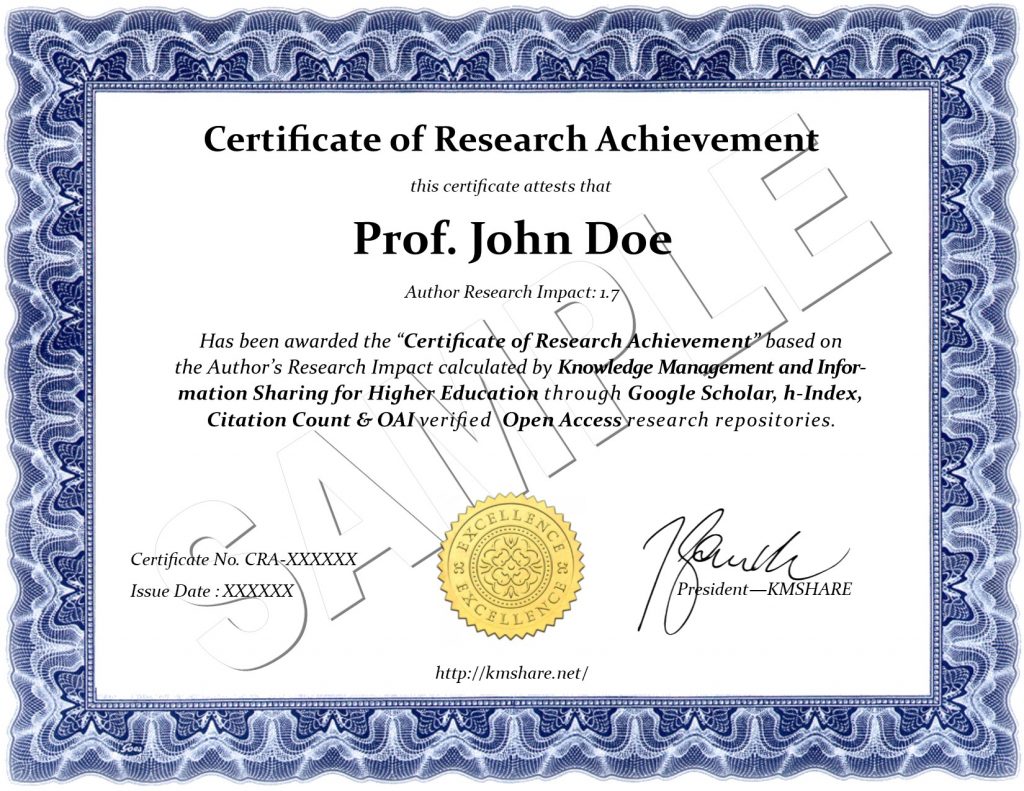
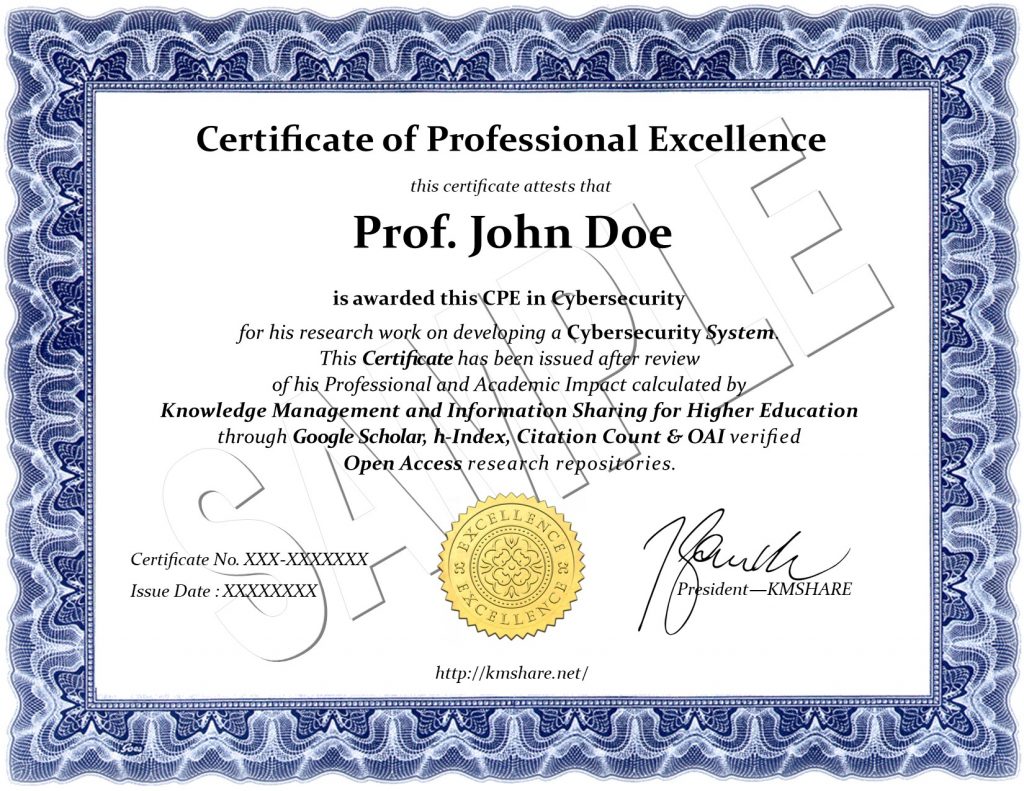
Ready to get certified?
The certificates attests to the professional accomplishments and the research achievements of the individual authors based on several factors, including h-index, citation analysis and web data through Google Scholar, h-Index, Citation Count & OAI verified Open Access research repositories.

- h-index: The h-index is an index to quantify an individual’s scientific research output (J.E. Hirsch).
- There are several databases (Web of Science and Google Scholar) that will provide an h-index for an individual based on publications indexed in the tools.
- Citation Analysis: Is the process whereby the impact or “quality” of an article is assessed by counting the number of times other authors mention it in their work.
- Webmetrics: Is a quantitative measure of the quality and quantity of attention that a scholarly work is receiving through social media, citations, and article downloads.
- Impact Factor: The impact factor is a measure of the frequency in which the average article in a journal is cited in a particular year. Impact factors measure the impact of a journal, not the impact of individual articles.
Apply for Your Certificate of Research Achievement NOW!
About Citation Analysis
What is Citation Analysis?
The process whereby the impact or “quality” of an article is assessed by counting the number of times other authors mention it in their work.
Citation analysis invovles counting the number of times an article is cited by other works to measure the impact of a publicaton or author. There is no single citation analysis tools that collects all publications and their cited references. For a thorough analysis of the impact of an author or a publication, one needs to look in multiple databases to find all possible cited references.
Citation Analysis – Why use it?
To find out how much impact a particular article or author has had, by showing which other authors cited the work within their own papers. The H-Index is one specific method utilizing citation analysis to determine an individuals impact.
About the H-index
The h-index is an index to quantify an individual’s scientific research output “J.E. Hirsch”.
The h-index is an index that attempts to measure both the scientific productivity and the apparent scientific impact of a scientist. The index is based on the set of the researcher’s most cited papers and the number of citations that they have received in other people’s publications. A scientist has index h if h of an author Np papers have at least h citations each, and the other (Np − h) papers have at most h citations each.
Author-level metrics
Author-level metrics are citation metrics that measure the bibliometric impact of individual authors. H-index is the best known author-level metric. Since it was proposed by JE Hirsch in 2005 it has gained a lot of popularity amongst researchers while bibliometics scholars proposed a few variants to account for its weaknesses (g-index, m-index are good examples).
Clarivate Analytics provides list of Highly Cited Authors. These are individuals who, in the last 10-year period, boast the highest cumulative number of highly cited papers (papers placing in the top 1% of the distribution) for their publications across 21 broad subject categories.
In other words, to have an h-index of 5, an author has to have 5 publications, each receiving at least 5 citations.
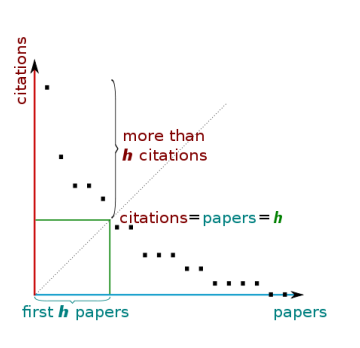

g-index is a variant of the h-index that, in its calculation, gives credit for the most highly cited papers in a data set. In the words of Leo Egghe, its inventor: “Highly cited papers are, of course, important for the determination of the value h of the h-index. But once a paper is selected to belong to the top h papers, this paper is not “used” any more in the determination of h, as a variable over time. Indeed, once a paper is selected to the top group, the h-index calculated in subsequent years is not at all influenced by this paper’s received citations further on: even if the paper doubles or triples its number of citations (or even more) the subsequent h-indexes are not influenced by this.” The g-index is always the same as or higher than the h-index.
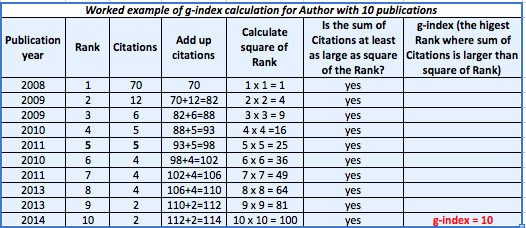
m-index is another variant of the h-index that displays h-index per year since first publication. The h-index tends to increase with career length, and m-index can be used in situations where this is a shortcoming, such as comparing researchers within a field but with very different career lengths. The m-index inherently assumes unbroken research activity since the first publication.
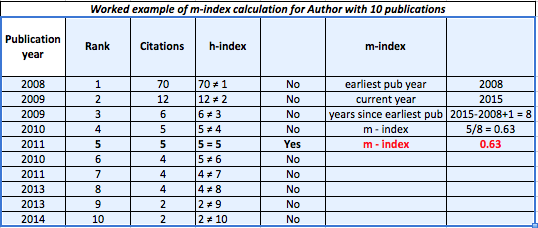
Apply for Your Certificate of Research Achievement NOW!
Where to find your h-index?
There are a number of sources where you can find your h-index. Please note that the value of the index may vary depending on the source of information (number of indexed publications, time span, etc.) For instance, h-index derived from Google Scholar tend to be higher than that based on Web of Science or SCOPUS data.
Google Scholar is the best source of h-index information. It requires creation of Google Scholar profile before providing metrics. Our Certificate of Reserach Achievement depends heavily on Google Scholar data.
In Web of Science you can see a calculated h-index for a group of publications (i.e. all publications by an author) through its author search.
Publish or Perish is a freely accessible software program that retrieves and analyzes academic citations. It uses Google Scholar to obtain the raw citations, then analyzes these and presents the following associated metrics:
- Total number of papers and total number of citations
- Average citations per paper, citations per author, papers per author, and citations per year
- Hirsch’s h-index and related parameters
- Egghe’s g-index (g-index)
- The contemporary h-index (m-index)
- The average annual increase in the individual h-index
- The age-weighted citation rate
- An analysis of the number of authors per paper.
Our methodology: The Certificate of Research Achievement is issued based on data submitted by the author and verified through google scholar h-index and citation count and other open access databases. We have recently included a large number of open access research archives to expand our h-index and citation base.